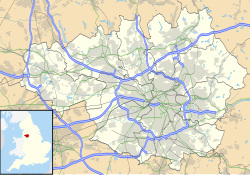Architecture
Higher Kinders is arranged in a large T-shaped plan and constructed in hammer-dressed stone, partly watershot, with a graduated stone-slate roof. [2] The building reflects the vernacular architecture of Saddleworth.
The west range, forming the head of the T, incorporates the earliest work. It is four storeys in height, with three bays, and has undergone extensions and alterations over time. The structure includes former loom workshops and a barn. [1]
Windows vary in size and style, featuring recessed chamfered cavetto-moulded mullions in groups of three, four, and seven lights, alongside flat-faced stone mullions in configurations of four, five, six, seven, and ten lights. Architectural details include an eaves cornice and ridge chimney stacks with cornices. [2]
The east range, forming the stem of the T, is three storeys, single-depth, and four bays long. It contains flat-faced mullion windows of two to ten lights, opposed cart entrances with segmental keystone arches, and an owl hole in the gable. [2] A flight of cantilevered stone steps rises within the angle of the T, providing access to former loom shops on the second floors of both ranges. Later additions include a 20th-century porch to No. 5 and shaped eaves gutter brackets. [1]
This page is based on this
Wikipedia article Text is available under the
CC BY-SA 4.0 license; additional terms may apply.
Images, videos and audio are available under their respective licenses.



